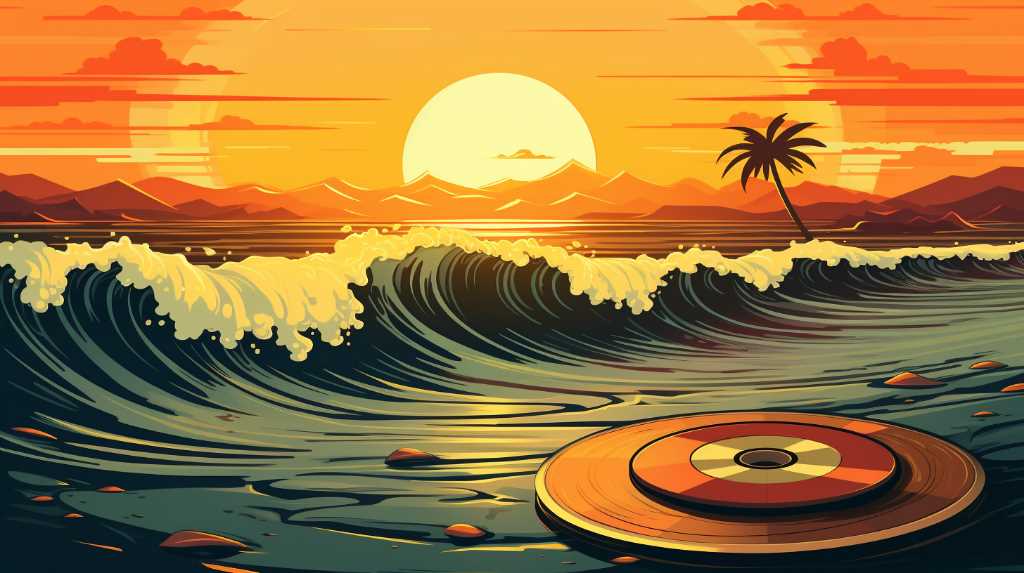
Instrumental surf music, known for its echoing guitar sounds and wave-like rhythms, made its mark in the 1960s in Southern California. This music wasn’t just tunes to listen to; it captured the lifestyle of young people who loved the beach and surfing. While Dick Dale and The Ventures are famous in this genre, there are many other great tracks that have shaped music even today.
We’re looking at how surf music uses guitar techniques to create its unique sound and why these songs still appeal to people. We’ll also consider what makes a song truly reflect the feel of the sea.
To give you a better idea, imagine the guitar in a surf music track as a surfer riding a wave – the way the guitar’s tremolo and whammy bar are used can make a song feel like the sea itself. It’s fascinating how these tunes have stayed popular over time, and it’s mainly because they capture the thrill of surfing and the beauty of the beach.
If you’re curious to dive into surf music, check out ‘Misirlou‘ by Dick Dale or ‘Walk, Don’t Run’ by The Ventures for a classic experience.
Origins of Surf Music
Surf music emerged in Southern California in the early 1960s, at the same time as the popularity of surfing was growing. This type of music is closely linked to the lifestyle of young people living by the sea, with its lively beats and guitar sounds filled with echo effects. Musicians like Dick Dale and The Bel-Airs were at the forefront of this movement. They captured the powerful and ever-changing nature of the ocean in their music. The use of echoes in surf music was done to replicate the sound of ocean waves and to give a sense of the ocean’s vastness.
To explain why this is important, surf music is not just about the sound but also about capturing the feeling of the surf culture. It’s a musical expression of the excitement and freedom associated with surfing. The echo effect used in the guitars is a specific technique that helps listeners imagine the expansive ocean. When we talk about surf music, we often recommend listening to tracks like ‘Misirlou’ by Dick Dale to really understand the energy and innovation of the genre.
Iconic Surf Music Artists
Surf music’s early stars, like Dick Dale, The Ventures, and The Beach Boys, shaped the sound of the genre. They were like the figureheads of the surfing world, capturing the lifestyle in their famous songs and guitar tunes.
Dick Dale was known for his fast picking on the guitar and using music scales from the Middle East in ‘Misirlou,’ showing off his impressive skills.
The Ventures added a smoother, more tuneful style to surf music, which you can hear in their classic song ‘Walk, Don’t Run.’ This made more people like surf music.
The Beach Boys added their own twist with their singing, stacking up vocal parts on top of each other. But they also stayed true to their surf beginnings with songs like ‘Surfin’ Safari.’
Each of these artists added their own special sound to the mix, and together they painted a picture of the exciting world of surfing. This has had a lasting effect, and you can still hear it in today’s music.
Essential Surf Tracks
Building upon the foundations laid by pioneering artists, a selection of seminal surf music tracks stands out for their enduring influence and distinctive sound that captures the essence of the genre. These tracks are not merely historical artifacts but are also the yardsticks by which all subsequent surf music is measured.
The reverb-soaked guitar riffs, the rapid percussive patterns, and the energetic basslines of these essential surf tracks form a sonic palette that conjures the image of sun-soaked beaches and rolling waves. Analyzing these compositions reveals a clever blend of simplicity and technical prowess, creating immersive soundscapes that are both accessible and deeply evocative.
They embody the carefree spirit and the thrills of surf culture, ensuring their place in the pantheon of classic instrumental music.
Modern Surf Music Evolution
Surf music has really changed over the years. It still has the classic surf sound with lots of reverb on the guitars, but now you can also hear punk, metal, and different kinds of beats mixed in.
Instead of just sticking to simple tunes, surf music now tries out more complicated and creative ideas. Thanks to digital tools, artists can play with a wider range of sounds and layer them to make the music more exciting.
Plus, indie and alternative music have added some new energy to surf tunes, proving that this kind of music can keep up with the times and still be cool.
Creating the Perfect Surf Playlist
Acknowledging the innovative blend of classic reverb-drenched guitars with contemporary influences, crafting a surf music playlist requires a discerning ear for both the genre’s roots and its modern iterations.
The quintessential surf playlist should start with the foundational tones of early pioneers, like Dick Dale’s ‘Miserlou,’ which captures the raw energy and rapid-fire plucking synonymous with surf rock’s inception.
Progressing through the decades, it’s crucial to incorporate the nuanced evolution of the style, selecting tracks that maintain the surf essence while experimenting with tempo, melody, and technological advancements in sound production.
An ideal compilation balances the ebb and flow of energetic peaks and mellower troughs, mirroring the ocean waves that inspired the genre, ultimately delivering an auditory journey that is both nostalgic and refreshingly contemporary.
Conclusion
Surf music is known for its echo-filled guitar tunes and lively beats. This kind of music started in the 1950s and 1960s, and it really captures the laid-back vibe of beach life. Even today, surf music is still popular and continues to grow by adding new sounds.
When you make a playlist of surf music, you’re not just remembering the great musicians from the past; you’re also helping to keep the music alive and fresh.
For example, if you add classic tracks like ‘Misirlou’ by Dick Dale to your playlist, you’re enjoying the same sounds that made surf music famous. But if you also include modern bands like The Growlers, you’re helping surf music to keep changing and stay interesting.
It’s like giving a high-five to the past and a thumbs-up to the future of this cool music style.








